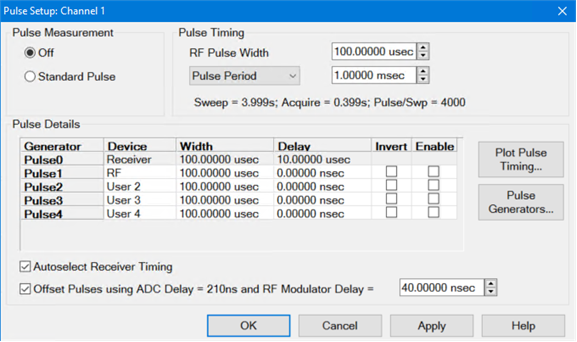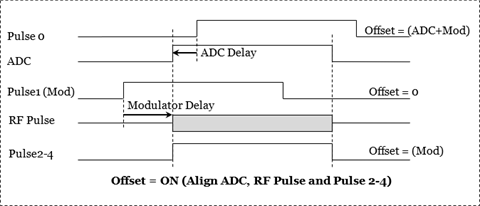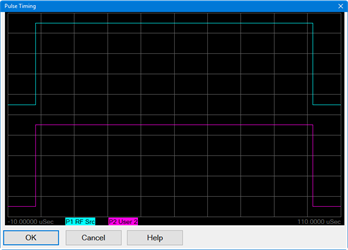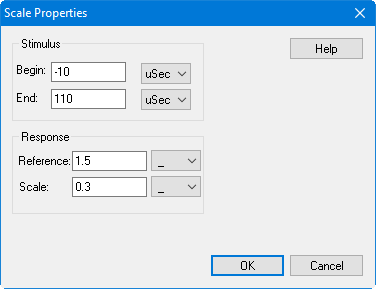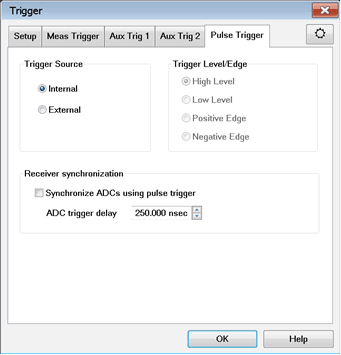|
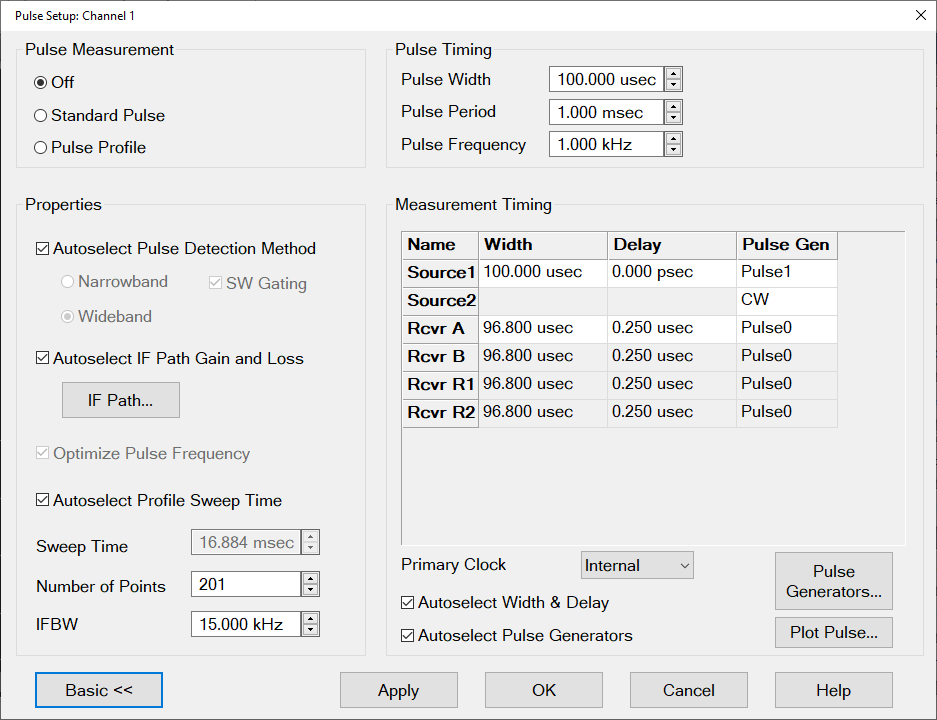
Note: The M937xA does not support this function.
The Basic controls allow simple pulse measurements using the default (Autoselect) settings in the Advanced section of the dialog.
Pulsed measurements are performed in a Standard channel. See Measurement Class. However, Several VNA measurement settings are controlled by the Pulse setup, such as sweep type, number of points, and so forth.
Pulse Measurement
Off - Source and Receivers are NOT pulsed
Standard Pulse - With pulsed RF, the VNA can be configured to sweep in frequency, power sweep, and CW time.
-
To make 'Point-in-Pulse' measurements, narrow the receiver pulse width and enter delay.
-
To make 'Pulse-to-Pulse' measurements, disable Autoselect Pulse Detection Method, then select Wideband. select Stimulus, then Sweep, then Sweep type = CW in the VNA menu.
Pulse Profile - Pulse profile measurements provides a time domain (CW frequency) view of the pulse envelope. Profiling is performed using a measurement technique that "walks" a narrow receiver "snapshot" across the width of the pulse. This is analogous to using a camera to take many small snapshots of a wide image, then piecing them together to form a single, panoramic view.
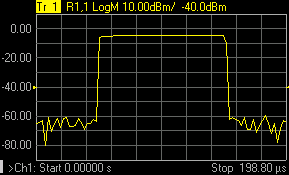
Pulse Profile measurement using default settings and R1 receiver.
-
Pulse Profiling can be performed using ratioed or unratioed measurements. You can preview the pulse on port 1 by using an R1 receiver measurement.
-
Pulse Profiling is performed at a single CW frequency in either Narrowband or Wideband mode.
-
To select the CW Frequency, click Stimulus, then Sweep Type.
-
In Narrowband mode, the delay increment value, which is responsible for "walking" the receiver snapshot across the pulse, is selected by the VNA and is accessible only with a programming command.
-
In Wideband mode, the receiver is walked across the pulse by making a sequence of closely-spaced measurements in real-time.
-
In SW Gating mode, software gating sensitivity is improved. When unchecked, all data outside the measurement band is zeroed. SW Gating mode is used for troubleshooting purposes.
Pulse Timing
Pulse Width - Sets the width of the source pulse. See measurement timing to learn how to control the receiver width and delay.
Pulse Period The time to make one complete pulse.
Pulse Frequency (PRF) The reciprocal of Period (1/ Period). See Internal Pulse Generators to learn more.
By default, these settings configure Pulse Gen 1 to drive Source Modulators 1 and 2. This can be changed from the Advanced Settings Pulse Generator Setup dialog.
-------- Advanced Settings ----------
The following settings allow maximum control of a Pulse measurement.
Note: When the "Auto" check boxes are cleared, it is possible to configure settings to make an invalid measurement.
Properties
Autoselect pulse detection method - check to automatically switch between Narrowband and Wideband based on the Pulse Width. .
In Standard Pulse:
-
Wideband - used when the (source) Pulse Width is WIDER than the fastest receiver acquisition time. This allows the receiver to measure all pulse ON time - no pulse OFF time. The VNA will select Wideband whenever possible.
-
Narrowband - used when the (source) Pulse Width is NARROWER than the fastest receiver acquisition time (267 ns). This measurement requires a spectral nulling technique to measure the pulse response through the DUT.
In Pulse Profile:
-
Wideband - used when the (source) Pulse Width is greater than 1.600 us. This allows the receiver make several sequential measurements to measure the entire pulse.
-
Narrowband - used when the (source) Pulse Width is less than or equal to 1.600 us.
Autoselect IF Path Gain and Loss - For future use.
IF Path - Click to launch the IF Path dialog.
Optimize Pulse Frequency - Automatically selects the Pulse Frequency and Pulse Period.
-
In Narrowband, the pulse frequency is adjusted slightly to get the best spectral-nulling filtering possible.
-
In Wideband, this checkbox is ignored.
Autoselect Profile Sweep Time - In Pulse Profile mode, adjusts the default X-axis start time to zero and the stop time double the Pulse Width. This allows you to see one complete pulse. If unchecked, the Sweep Time will not be changed.
To adjust the X-axis manually, click OK to close the dialog. Then press Sweep > Main, then change the Start Time and Stop Time.
Sweep Time - Sets the time the analyzer takes to complete one sweep.
Number of Points - Sets the number of data points for the measurement.
IFBW - Select the IFBW for the measurement.
-
In Narrowband, an IFBW as close as possible to the entered value will be used.
-
In Wideband, this setting determines the receiver acquisition time - approximately 1/ IFBW.
Measurement Timing
Port n, Rcvr - Used as RF Source Modulation Drive.
-
Width - source pulse width.
-
Delay - source pulse delay relative to the pulse generator clock.
-
Pulse Gen - Pulse generator used to modulate the source. Select CW to have NO source modulation.
The receiver settings in this table change depending on whether the VNA is in Narrowband or Wideband mode.
-
In Narrowband, for each IF receiver path, configure the Pulse Width, Delay, and Pulse Generator to be used to drive the receiver gate.
-
In Wideband, all receiver paths are the same.
Primary Clock
The Primary Clock is controlled by the internal or external pulse generator and is the primary pulse clock. The Internal and External selections are not the same as the Trigger Source Internal and External selections found in the Pulse Trigger tab of the Trigger dialog. However, they are inter-related as follows:
|
|
Primary Clock
|
Trigger Source (from Pulse Trigger tab of Trigger dialog)
|
|
|
Primary pulse clock controlled by selected pulse generator.
|
Trigger source for the internal pulse generator.
|
|
Internal
|
|
-
Trigger is self-generated in the internal pulse generator.
-
The trigger source for the internal pulse generator trigger is set to Internal and is reflected in the Trigger Source selection in the Pulse Trigger tab of the Trigger dialog.
|
|
External
|
-
The primary pulse clock is an uncontrolled external pulse generator.
-
PRF settings are determined by the external pulse generator, which the VNA firmware does not control. The user must set up the external system clock. Entries for frequency and period in the VNA GUI dialogs will have no effect.
|
-
Trigger comes from the PULSE I/O connector (PulseSyncIn) on the rear panel.
-
The trigger source for the internal pulse generator trigger is set to External and is reflected in the Trigger Source selection in the Pulse Trigger tab of the Trigger dialog.
|
|
Other selections
|
If there is a defined pulse generator in the external devices list, its name will be displayed in the Pulse Setup dialog Primary Clock control and it will also be an accepted choice for the SENSe:SWEep:PULSe:PRIMary:CLOCk SCPI command.
|
|
Autoselect Width and Delay - When checked, for Wideband mode and Pulse Gen = Pulse Trigger, the default setting for the receiver is adjusted to approximately 75% of the source pulse width, with 20% delay. This leaves approximately 5% of the source pulse ON after acquisition is complete.
When checked for Narrowband mode and Pulse Gen <> CW, then Delay and Width matches the RF Source.
Autoselect Pulse Generators - When checked:
-
Pulse1 is selected for Modulator Drive.
-
Pulse2 is CW (OFF).
-
For Wideband, Pulse Trigger is selected to gate the ADC.
-
For Narrowband, Pulse2 is selected.
Pulse Generators... Click to launch the Pulse Generators Setup dialog.
Plot Pulse... Accesses the Pulse Timing dialog, which displays an interactive screen for evaluating the pulse timing setup.
Plot Pulse is enabled for Pulse Profile measurements in N524xB and N522xB models, but disabled in all other models.
Plot Pulse is disabled for all NarrowBand pulse measurements.
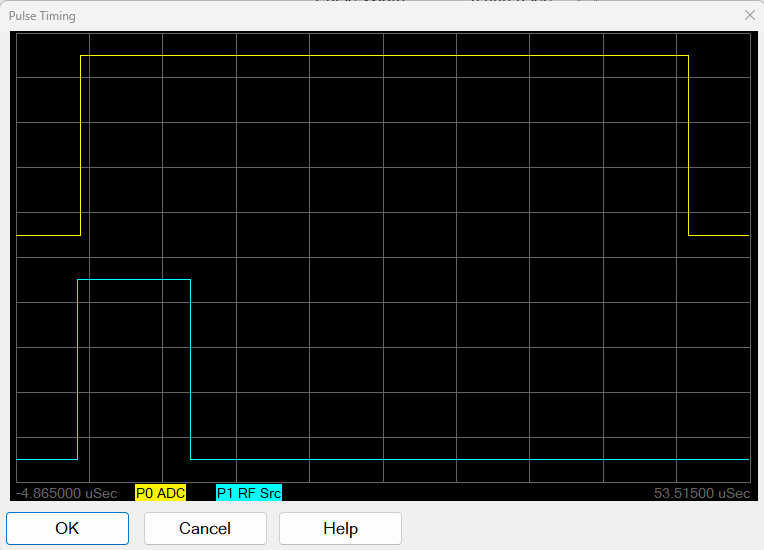
Right-click in the display area to access the following menu:

Autoscale - Automatically scales the data to fit vertically within the display grid area.
Display marker annotation - Select to display marker annotation in the top-right of the display.
Show graticule - Select to display graticules.
Add marker to: - Select to add a marker to a displayed pulse trace. When a selection is made, the mouse pointer changes to a "+". Click in the display area and the marker will appear. Drag the marker to the desired position. Each time this selection is made, a new marker will be added.
Copy to Clipboard - Copies a bitmap of the trace control (Display) to the clipboard. It can then be pasted into any document that accepts bitmaps.
Print... - Prints the displayed data.
Scale properties... - Accesses the following dialog:
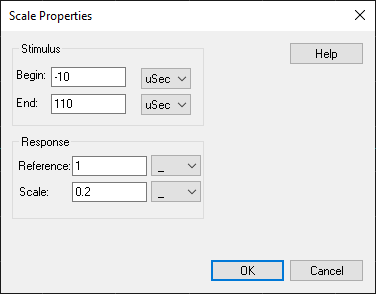
Stimulus - Sets the Begin and End displayed on the X-axis in seconds.
Response - Sets the Reference level in the center of the Y-axis and sets the scale per division.
|





